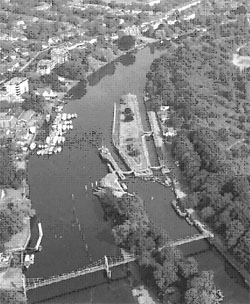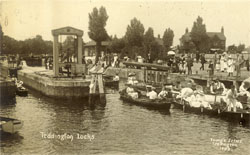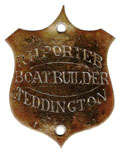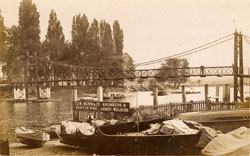Teddington Riverside
Locks, suspension bridge and a film studio

In early times a ditch ran along the north side of Teddington High Street, stretching from the village pond to the River Thames. This was graphically described as the village drain. In 1655 it was ordered that 'the common water course running through the town be thoroughly cleaned by each man so far as his house and land goeth'. The combination of all manner of rubbish, including dead animals, being flushed into a shallow river would have increased its pollution. In the 1750s Dr Stephen Hales, parish curate and noted scientist, whose property bordered the ditch, addressed the problem: additional channels were dug to improve the water flow, and these were highly successful.

Down on the river the shallows continued to give much trouble and in 1775, for example, there were often 20 barges stranded in shallow water. The way to resolve this was to drive “stops”: low barriers of piles and planks across part of the water course. These channelled the flow of water to scour out a navigable passage. But this was never satisfactory for long although help would be given by the surge of water released from the flash locks upstream. At this time the river was only tidal as far as Richmond. Eventually a pound lock, of the type we know today with gates at each end was built at Teddington in 1811 with an accompanying weir. The lock has been rebuilt several times since.
Both linen and wax bleaching were carried out in fields between the river and Broom Road. John Rocque's map of 1746 shows “Mr Goodchild's bleach-field for Scotch and Irish linen”. A wax factory was established by Alexander Barclay in about 1800. Wax was melted and passed through a perforated trough over cylinders revolving in cold water, which fashioned it into long shavings. The shavings were then spread on tables in the field, exposed to the weather for three weeks and turned each morning. The wax was bleached almost white and transparent.
Boatbuilding is not recorded here until James Arthur Messenger opened his boatyard in 1848. There are, however, early records of watermen and lightermen: an 1823-24 directory lists William Kemp, waterman, a member of the Kemp family who were longstanding fishermen in Teddington.

Messenger expanded his boatyard, becoming Royal Bargemaster in 1862. He took an additional yard in Kingston, employing 30 men by 1871. In about 1875 he built, to Sir Henry Morton Stanley's specification, the ten-oared, five-sectioned “Lady Alice”, specially designed to be dismantled for overland transportation.

This boat played an important role in Stanley's African explorations. The yard passed to Porter & Brice in 1895 and in 1934 the British Motor Yacht Club acquired the premises.

Another small boat building firm was run by Tom Bunn at the Ferry Road boatyard. Later this yard was acquired by the Tough brothers. Toughs were in business during World War 1 when they built, for Thornycrofts, one of a pair of gunboats. Named Toutou and Mimi, these were taken to Lake Tanganyika in 1915. Forty feet long and with a beam of eight feet this was an arduous journey over sea and land. During a successful engagement on the lake a German gunboat was captured and, renamed Fifi, made up the trio. During World War 2, with a labour force increasing from 16 to 220, Toughs built many craft for the Admiralty.
At the end of Ferry Road a footpath leads to the pedestrian suspension bridge built in 1899. A ferry service also operated, until the 1950s, taking passengers to the lock island from where they would cross the lock bridge to get to the Ham side of the river.

Several large houses on the riverside of Broom Road were built in the 1850s. These included Weir House which was leased by Ec-ko Films in 1912. The studios were acquired by Warner Brothers in 1931 for their European production centre. Later sold to ABC Television in 1955 and to Thames Television in 1968, the buildings are still in use today as independent studios. Four other houses: Rock Hall, Dunbar House, Weirbank and New Broom Hall were acquired by the Shell Company in the 1920s and used as their sports club until demolished when the new Lensbury Club was rebuilt in the 1930s.



